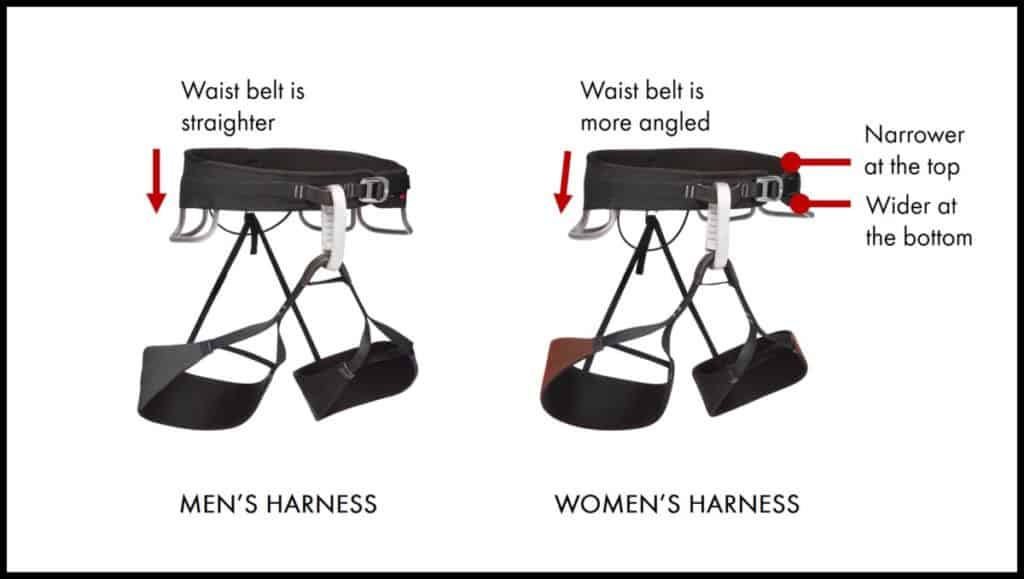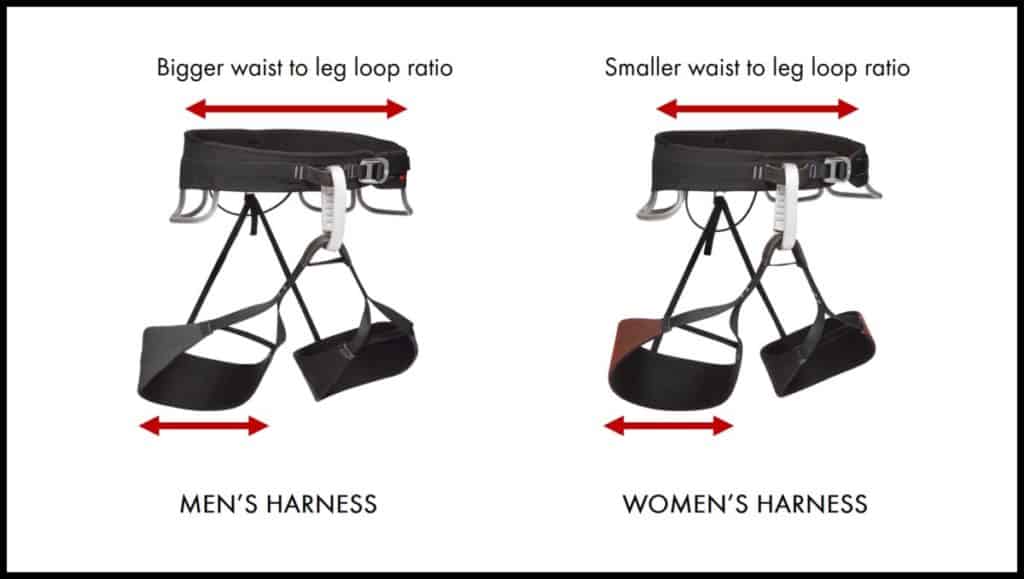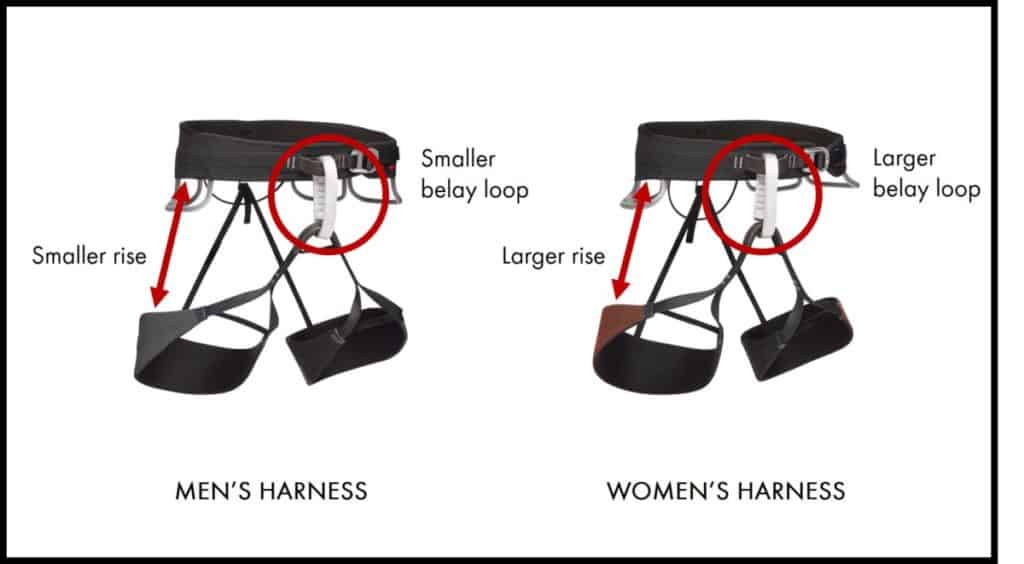For a long time, climbing harnesses used to be a unisex piece of gear. But over the years, many brand names have designed harnesses specifically for women. I wanted to find out if there were real differences between men’s and women’s climbing harnesses.
So what are the differences between men’s and women’s climbing harnesses? There are 3 main differences between men’s and women’s climbing harnesses:
- The waist belt and leg loops of a women’s harnesses are farther apart than men’s.
- For a harness with the same leg loop size, the waist belt of a women’s harnesses is narrower.
- The waist belt of a women’s harnesses is slightly angled to be narrower at the top and wider at the bottom.
The introduction of women’s climbing harnesses is actually a good thing for both men and women. Some women have found that men’s climbing harnesses are a perfectly good fit for them. And some men found women’s climbing harnesses to be a more comfortable alternative.
Do not restrict yourself to a gender-specific harness. It’s more important to get a harness that fits your specific body shape. Besides the differences mentioned above, there are other features to look out for when buying a harness.
| Looking to buy your first set of climbing equipment? Find out what you need in this beginner’s guide — Mountaineering Tools And Equipment 101. |
Anatomy Of A Climbing Harness

Waist belt: As its name implies, this is the part of the harness that goes around your waist. Harnesses come in different sizes so you can pick one that best fits your waist size. But there are also 1 or 2 buckles on the waist belt that you can use to further adjust the fit.
Gear loops: You will usually find 4 gear loops on your waist belt, 2 on each side. These loops are used to carry your climbing gear such as carabiners and quickdraws. They are semi-rigid so that you can clip in and remove your gear easily. They can carry a decent amount of equipment but they are not designed to take human load. You should never use them to attach yourself to an anchor point or belay.
Leg loops: The leg loops go around your upper thigh. Harness of different sizes will have different dimensions for the leg loops. Unlike the waist belt, the leg loops may or may not have buckles to further adjust the fit.
Tie in loops: There are 2 tie in loops on the front of your harness. 1 is at the center of your waist belt. The other is leading up from the 2 leg loops. The 2 tie in loops are connected by the belay loop (see next item). When you are climbing, you will tie yourself into a rope using the tie in loops. The rope has to be looped through both tie in loops. This will distribute your weight and add redundancy during a fall. The tie in loop is only used to tie in the rope. Do not pass a carabiner through the loops and use that for belaying. Belaying should be done through the belay loop.
Belay loop: The belay loop connects the 2 tie in loops. This is the strongest point on the harness. To belay a climber, attach a carabiner to the belay loop. Secure the rope to the belay device. Then attach the belay device to the carabiner. Do not tie a rope or other cords around the belay loop. This will damage the belay loop and cause faster wear and tear.
Rise straps: These are straps connecting the waist belt and leg loops. They can be adjusted for a better fit. Some climbing harnesses have the straps are sewn in place. Other harnesses have straps that can be detached easily. The straps that connect the leg loops to the back of the harness can be detached for many harnesses today. This allows you to go to the bathroom easily without taking off the whole harness.
How To Decide Between A Men’s Or Women’s Climbing Harnesses
Now that you are familiar with the anatomy, let’s look at how to decide between a men’s or women’s climbing harnesses.
It is difficult to select a harness without trying it on. Most harnesses only specify the waist belt and leg loops dimensions. There are numerous parts of a harness that can cause discomfort if it doesn’t fit your body properly.
Take Your Measurements
- Measure your waist. This should be measured just above your hip bone, in line with your belly button. Ensure your measuring tape is kept level from front to back. take the measurement when you exhale. Do not suck your tummy in.
- Measure your thigh at the thickest part. Ensure your measuring tape is kept level from front to back.
- Check the harness sizes for one that’s the closest fit. This is a good place to start.
Put On The Harness
- Loosen the buckles and straps on the waist belt and leg loops.
- Look for the front of the harness. This is where the tie in loops and belay loop are.
- Step into the harness like how you would put in a pair of pants. Make sure the waist belt and leg loops are not twisted or upside down.
- The bottom of the waist belt should be just above your hip bone. The waist belt should be covering your belly button. Do not wear it like a hipster! If the waist belt is too low, you are not secured properly in your harness. If you fall upside down, you risk slipping out of the harness.
- Tighten the buckle on the waist belt. Make sure it isn’t too tight that you can’t breathe. When you breathe out, you should be able to slot no more than 2 fingers between your waist and your harness.
- The leg loops should be around your upper thighs, just below the groin.
- Adjust the straps on the leg loops, if any. You won’t need to worry too much about how tight or loose the leg straps are. A comfortable fit will be about 2 fingers gap between your thighs and the leg loops. If they are too tight, they will pinch into your thigh when you are walking or climbing. If they are too loose, it may be uncomfortable when you are sitting on the harness. It may also cut into your thigh when you fall during a climb.
The real test for a harness comes when you are hanging off and sitting onto the harness.
But first, walk around to test the general fit and comfort of your harness.
Check The Initial Fit
Check the fit at the waist belt:
- The waist belt should rest comfortably around your waist. You should not feel the top or bottom of the waist belt jutting into your waist.
- If you feel the top part of the waist belt jutting into your waist, you should try out the men’s harness.
- If you feel the bottom part of the waist belt jutting into your waist, you should try out the women’s harness.

The waist belt of a men’s harness is a straighter cut.
The waist belt of a women’s harnesses is slightly angled to be narrower at the top and wider at the bottom. It is to accommodate a narrower waist and wider hips.
Check the fit at the leg loops:
- It is more important to have a good fit at the waist than around your thigh.
- If your waist belt is fitted properly but your leg loops are too loose, swap from a women’s harness to a men’s harness.
- If your waist belt is fitted properly but your leg loops are too tight, swap from a men’s harness to a women’s harness.

The sizes of the waist belt and leg loops are usually closer for a men’s harness.
For a women’s harness, the waist belt sizes are usually narrower for the equivalent leg loops size.
Check the position of the leg loops:
- The leg loops should be around your upper thigh, just below the groin.
- You can test it more effectively when you are roped in and sitting on the harness.
- For now, go into a half squat to simulate a sitting position.
- If the leg loops cut uncomfortably into your groin, the rise of the harness may be too short for you. swap from a men’s harness to a women’s harness.
- If the leg loops are around your mid-thigh or lower towards your knees, the rise is too long. Where appropriate, swap from a women’s harness to a men’s harness.

The waist belt and leg loops for a men’s harness are usually closer together, i.e. a shorter rise.
The waist belt and leg loops of a women’s harnesses are usually farther apart, i.e. a longer rise.
The easiest way to compare the rise of harnesses is to look at the belay loop. A harness with a longer rise will typically have a bigger belay loop.
Sometimes, swapping between the gender-specific harness may not work. You can also try going one size up or down. Sometimes, you may need to change to a different model or brand to fit a better fit.
Check The Fit When Sitting On The Harness
Now comes the real test.
Some sporting stores may have a section where you can hang on a rope and test it in the actual use conditions. If not, check with the store on their return policy if the harness does not work out.
- Sit back on your harness. You should not be falling backward. You should be sitting relatively upright just as you would in a chair with minimum effort.
- The leg loops should not be too high and cutting into your groin area. If they are, You will need a harness with a longer rise. Adjust the straps on the back of the leg loops to adjust the rise. Where appropriate, swap from a men’s harness to a women’s harness.
- The leg loops should not be too low either. When you are sitting back on your harness, your sitting posture will be supported by the leg loops. If you find yourself slumping back, with your thighs coming very close to your stomach area, your leg loops may be too low on your thigh. You will need a harness with a shorter rise. Adjust the straps on the back of the leg loops to adjust the rise. Where appropriate, swap from a women’s harness to a men’s harness.
- Check that the waist belt is not shifting too much. Lean back and put more weight on your hip. Check if you are slipping out of your harness. You should not slip out of your harness even when you are upside down.
- Check again that the waist belt is not cutting into your waist at any point. Check that you don’t feel any sharp pressure from the harness cutting into any parts of your body. Many harnesses have cushions or padding on the side of their waist belts and leg loops. Check that they feel comfortable.
Types Of Climbing Harnesses
Harnesses are typically designed for different types of climbing activities:
- Gym or competition harnesses: Sport climbing or climbing in a gym are usually short and quick climbs. These harnesses are designed to be lightweight.
- Traditional harnesses: Traditional climbing requires more gear and takes more time. These harnesses are designed to be more comfortable and can hold more gear.
- Ice harnesses: Similar to traditional harnesses but designed for the cold temperatures and wet conditions.
- Alpine or mountaineering harnesses: These harnesses are designed to be lightweight and easy to put on and remove. They are also designed for cold temperatures and wet conditions.
- Body harnesses: These harnesses are designed for situations where climbers have a higher risk of flipping upside down. Children often also use body harnesses for climbing as they have a higher center of gravity.
Other Considerations When Choosing Your Harness
But many harnesses these days are designed to be more versatile. They can be used for multiple types of climbing activities.
These are the features to consider when you are picking out your harness:
Type of waist buckle
Traditionally, the buckle on the waist belts are secured by “doubling back” the strap. Newer harnesses have buckles that lock automatically. Automatic locks are faster to secure. But some climbers find that the manual double back buckles are more secure and do not loosen during a climb.
Here you can see how a double back buckle works:
And here you can see how an automatic lock buckle works. You just pull to tighten and the strap is automatically locked in place.
Adjustability of the waist belt and leg loops
This is important if you are using the harness in summer and winter conditions. Make sure the harness can fit comfortably even when you are all wrapped up in winter clothing.
Number of gear loops
Harnesses usually have 2 to 4 gear loops. Personally, I think having more gear loops is better since you have the option to hang more gear if needed. A couple of extra gear loops is not going to add a lot more weight to the harness. Some harnesses also have a haul loop at the back of the harness. This is useful for carrying an extra piece of rope.
Position of gear loops
If the gear loops are too far back, it can be difficult to access your gear. They also should not be too far in front. Otherwise, the gear will interfere with your climbing. Try to clip in and remove a few carabiners to see if the gear loops are easy to use. For alpine climbers or mountaineers, having thick gear loops at the back is uncomfortable when the backpack is pressing down on it.
Width of leg loops
If the leg loops are too narrow, they will cut into your thigh and even cut off the blood flow to your legs after a long time.
Padding around the waist belt and leg loops
If you are spending a lot of time sitting on the harness, a thicker padding will provide better lumbar support. It will also prevent the blood flow from getting cut off by the straps in your harness. But a thick padding is less comfortable to walk in. for alpine climbers or mountaineers, a thick waist belt padding is uncomfortable when the backpack is pressing down on it.
Detachable straps
As mentioned earlier, it is useful when you can easily detach the straps from the back of the waist belt to the leg loops. This allows you to go to the bathroom easily without taking off the whole harness. For harnesses designed for alpine climbing, the leg loops can be opened up completely. The harness can be worn the same way you would wrap a towel around your waist. Most of the time, you will have to put on the harnesses in the same way you would put on pants. With leg loops that open up, you can put on the harness the same way you would wrap a towel around your waist. This is very helpful for alpine climbers who are wearing crampons.
Here you can see how an alpine harness can be opened up completely:
Weight
Lightweight harnesses typically weigh about 9 to 10 ounces (255 g to 280 g). Other harnesses can go up to 16 ounces (450 g).
Cost
You can find a decent climbing harness for USD 60 to USD 90. Higher end models go for about USD 100 to USD 120, and can even go up to USD 200.
Common Brands Of Harnesses
These are the common brand names for climbing harnesses:
- Arc’teryx
- Black Diamond: Their harnesses usually have a longer rise. They have a good leg loop adjustment system.
- Camp: Their harnesses usually have a longer rise.
- Edelrid
- Mammut: Their harnesses usually have a good leg loop adjustment system.
- Petzl: Their harnesses usually have a shorter rise and smaller leg loops.
Final Words
There is no one size fits all when it comes to harnesses.
The size and fit will vary between brands and models.
Do not just buy the first harness you put on! You should try out at least 3 to 5 different harnesses to compare and find out what works.
| Find out what other equipment you need in this beginner’s guide — Mountaineering Tools And Equipment 101. |
